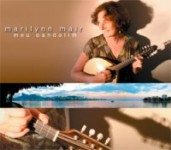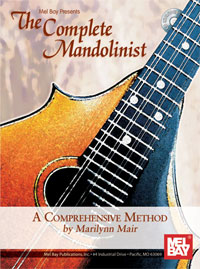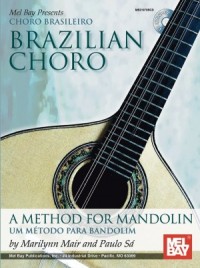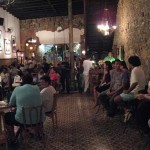 I have played for beer! As any musician knows that’s a rite of passage and now I’ve got there with my as-yet-unnamed Brazilian “regional” ( the name for a local band). It happened Friday in Santa Teresa. But that’s the end of this chapter. I ended my last log on March 27th with me having a chill day. But at 10:00 that night Roberto knocked on my door and said that Sueli was coming over to pick him up to go to hear a friend of their’s play choro – did I want to go? Porque nao?
I have played for beer! As any musician knows that’s a rite of passage and now I’ve got there with my as-yet-unnamed Brazilian “regional” ( the name for a local band). It happened Friday in Santa Teresa. But that’s the end of this chapter. I ended my last log on March 27th with me having a chill day. But at 10:00 that night Roberto knocked on my door and said that Sueli was coming over to pick him up to go to hear a friend of their’s play choro – did I want to go? Porque nao?
We go to Trapiche de Gamboa and meet the band coming back in for the 2nd set. I recognize some of them as teachers at choro school. And the bandolimist is one of the hot-shot students from the Bandolim 3 class. Muito legal! There are no tables so we settle in at the bar. The band is smoking – mixing choro with jazz in a free approach that has them all laughing and enjoying what each other is doing. Sueli’s friend, Eduardo Neves, is a superb flute and sax player, and the clarinetist, Rui Alvim, is also great. The bandolimist, Luiz Barcelos looks to be in his early 20’s and is a really good player and interesting musician. Alas, my recorder arrives with dead batteries – I must have left it on accidentally. I do take a couple of tune-films and a couple of really blurry pics (and one good one that you see here). The bar is in a factory district – I am told many times not to come here alone unless I’m brought by TaxiPaulo. Sueli car is “guarded” by a funny loquacious fellow while we are in the club, and he gets a couple of $R for his effort.
Wednesday I meet Paulo Sa in Centro and he takes me to a good music bookstore where I buy a choro history book and the Jacob play-along book plus 2 CDs. We get some lunch and he calls TaxiPaulo to pick me up at the Central Bank instead of Urca for my lesson with Joel. The lesson is completely great – I start out with E Do Que Ha – a Luiz American tune that immediately has him giving me interpretation tips. All continues well and he has some interesting ideas for me to try in my playing. I feel that I’m making progress and he is understanding what it is that I’m trying to do here. It’s all good.
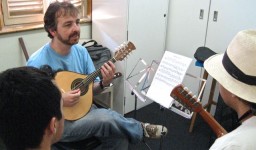 Thursday I pick up my copies of Henrique’s manuscripts at UniRio, and then meet Paulo again downtown, and he takes me by the club where Pixinguinha always hung out on our way to one of his bandolim classes at the Villa-Lobos Institute that he’s invited me to sit in on. It’s 4 college-age boys, one of whom is in my class at choro school. It’s interesting to hear Paulo work with them on improvisation. They get to go to the school for free, as long as they pass regular juries to be sure that they are progressing. Before they can start any instrument they have to learn solfege and some theory. They use the fixed-do method here, which caused me some confusion initially when Joel or Pedro would say the note names to me in class, as I’m used to “do” being the tonic (moveable-do), not always “C”. They never use letter names for notes or chords, always their scale names in the key of C.
Thursday I pick up my copies of Henrique’s manuscripts at UniRio, and then meet Paulo again downtown, and he takes me by the club where Pixinguinha always hung out on our way to one of his bandolim classes at the Villa-Lobos Institute that he’s invited me to sit in on. It’s 4 college-age boys, one of whom is in my class at choro school. It’s interesting to hear Paulo work with them on improvisation. They get to go to the school for free, as long as they pass regular juries to be sure that they are progressing. Before they can start any instrument they have to learn solfege and some theory. They use the fixed-do method here, which caused me some confusion initially when Joel or Pedro would say the note names to me in class, as I’m used to “do” being the tonic (moveable-do), not always “C”. They never use letter names for notes or chords, always their scale names in the key of C.
 That evening Sueli has invited Roberto and me to go hear her all-woman samba band “Orchestra Luna” play at the Rio Scenarium. “Invited” means we don’t have to pay the cover, I find out later. The club is very retro-cool and very red and the band is great. Sueli plays flute and baritone sax. The horn section also has alto sax and trombone and the women really rock. The rest of the band includes keyboards, electric bass, cavaquinho, a drummer and a percussionist, and a singer on about half of the tunes. The club is in Lapa – so I get to go there for the first time. Lapa looks like
That evening Sueli has invited Roberto and me to go hear her all-woman samba band “Orchestra Luna” play at the Rio Scenarium. “Invited” means we don’t have to pay the cover, I find out later. The club is very retro-cool and very red and the band is great. Sueli plays flute and baritone sax. The horn section also has alto sax and trombone and the women really rock. The rest of the band includes keyboards, electric bass, cavaquinho, a drummer and a percussionist, and a singer on about half of the tunes. The club is in Lapa – so I get to go there for the first time. Lapa looks like  something out of a Fellini film. (Did I just imagine the mist or was it really there?) On the way to the club we pass a small bar where an older guitarist is playing and singing bossa nova. I peer in and note the familiar sounds kindof automatically and then the earth-shaking realization come crashing down on me – I am listening to bossa nova in Rio. Really it nearly knocks me over, like running into the huge wall of Brazilian music history and it’s real and not a made-for-TV movie. A big wow moment.
something out of a Fellini film. (Did I just imagine the mist or was it really there?) On the way to the club we pass a small bar where an older guitarist is playing and singing bossa nova. I peer in and note the familiar sounds kindof automatically and then the earth-shaking realization come crashing down on me – I am listening to bossa nova in Rio. Really it nearly knocks me over, like running into the huge wall of Brazilian music history and it’s real and not a made-for-TV movie. A big wow moment.
We talk to Sueli at both breaks. At the first one she is feverishly rearranging music in her folder for the new set lists as the band literally goes right from song to song without a pause. There’s all sorts of dancing,  from gaufieri that goes back to Chiquinha Gonzaga in the late 19th-century, to the dread-locked rasta guy’s frenetic slam-dance. At the 2nd break Sueli tells me I must go up to look at the upper floors so, when the music ends, Roberto and I do. There’s a couple of pics here but it hardly conveys the surreal atmosphere. Cases crammed with dolls and glass knick-knacks, chairs nailed upside down on the ceiling, collections of old electric fans and metal chairs, pictures of 30s bathing beauties, band instruments nailed to the walls, Art Noveau sculptures of women hanging from the ceiling, and copies of greek sculptures beside 40’s red furniture and old record players with sound horns.
from gaufieri that goes back to Chiquinha Gonzaga in the late 19th-century, to the dread-locked rasta guy’s frenetic slam-dance. At the 2nd break Sueli tells me I must go up to look at the upper floors so, when the music ends, Roberto and I do. There’s a couple of pics here but it hardly conveys the surreal atmosphere. Cases crammed with dolls and glass knick-knacks, chairs nailed upside down on the ceiling, collections of old electric fans and metal chairs, pictures of 30s bathing beauties, band instruments nailed to the walls, Art Noveau sculptures of women hanging from the ceiling, and copies of greek sculptures beside 40’s red furniture and old record players with sound horns.
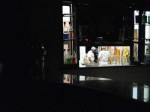 Sueli has gone by time we get back down but Roberto introduces me to Sheila, the keyboard player, who has just recorded a duo CD of choro/jazz with saxophonist Daniella Speilman. She says I have to meet Daniella because she knows everyone in choro, and it suddenly occurs to me to ask if she’s the pregnant woman playing with Paulo Moura on the Brasileirinho DVD. Yep, she is – amazing. Sheila takes my number and
Sueli has gone by time we get back down but Roberto introduces me to Sheila, the keyboard player, who has just recorded a duo CD of choro/jazz with saxophonist Daniella Speilman. She says I have to meet Daniella because she knows everyone in choro, and it suddenly occurs to me to ask if she’s the pregnant woman playing with Paulo Moura on the Brasileirinho DVD. Yep, she is – amazing. Sheila takes my number and 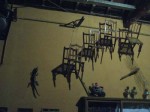 says I should call her to get Daniella’s number too. By now it’s after 3:00 AM, as the band didn’t start playing until 10:30, so we say good-bye to all and go back to Candida Gauffree.
says I should call her to get Daniella’s number too. By now it’s after 3:00 AM, as the band didn’t start playing until 10:30, so we say good-bye to all and go back to Candida Gauffree.
Friday I go downtown to pick up a ticket for the Guinga show that’s on Saturday, as it’s reserved seating, and then head to the beach. In the evening I go to hear and meet bandolimist Rodrigo Lessa at what turns out to be a Cuban cigar bar. The music is cool – he’s playing with a 7-string and a drummer – but the smoke nearly kills me so I leave after the 1st set.
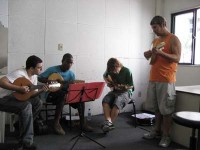 Saturday is Choro school. Rui Alvim (clarnetist at the Tuesday session) is teaching my repertory class and we work on Chorando Baixando. He organizes us like a regional, and I’m told to play the lead on the first B section, and improvise a counter line on the first C. I get to do 2 bandolim classes again this week. The girl from Bandolim 3 has opted to join us in level 2,and many others have not returned so level 3 is down to the 3 hottest of the hotshots. Luiz B is pleased when I compliment his performance
Saturday is Choro school. Rui Alvim (clarnetist at the Tuesday session) is teaching my repertory class and we work on Chorando Baixando. He organizes us like a regional, and I’m told to play the lead on the first B section, and improvise a counter line on the first C. I get to do 2 bandolim classes again this week. The girl from Bandolim 3 has opted to join us in level 2,and many others have not returned so level 3 is down to the 3 hottest of the hotshots. Luiz B is pleased when I compliment his performance 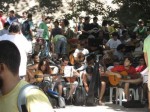 on Tuesday. I film some of the level 3 class and record the all-school Bandao and takes some pics that you see here. I meet my whole regional for the first time, and we’ve picked up a flutist and a 3rd pandeiro player, who turns out to be from Burlington VT and plays in Will Patton’s Brazilian group. Small world. She’s only here for a couple more weeks so is just visiting choro school for today.
on Tuesday. I film some of the level 3 class and record the all-school Bandao and takes some pics that you see here. I meet my whole regional for the first time, and we’ve picked up a flutist and a 3rd pandeiro player, who turns out to be from Burlington VT and plays in Will Patton’s Brazilian group. Small world. She’s only here for a couple more weeks so is just visiting choro school for today.
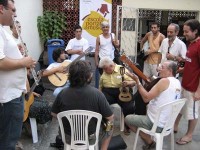 Those of you coming to Rio might be interested to know that foreigners who want to sit-in on choro school for one or two Saturdays can do so, for just $25R/Saturday, and you don’t have to audition. Our regional plays through some choro and Romulo, our self-appointed leader, collects email and phone numbers and arranges our next rehearsal for Friday in Santa Teresa. I walk out of rehearsal to find a very cool roda with lots of the teachers playing. There’s a pic here and I have a couple of films. Before I know it it’s 5:30 (we started at 9:00 AM) and I have to run home and change and get to my Guinga show, so can’t go out for a beer with Bonnie, Romulo, and some of the others.
Those of you coming to Rio might be interested to know that foreigners who want to sit-in on choro school for one or two Saturdays can do so, for just $25R/Saturday, and you don’t have to audition. Our regional plays through some choro and Romulo, our self-appointed leader, collects email and phone numbers and arranges our next rehearsal for Friday in Santa Teresa. I walk out of rehearsal to find a very cool roda with lots of the teachers playing. There’s a pic here and I have a couple of films. Before I know it it’s 5:30 (we started at 9:00 AM) and I have to run home and change and get to my Guinga show, so can’t go out for a beer with Bonnie, Romulo, and some of the others.
 I arrive at Rival Petroblas just in time for the show. The first row of tables is up against the stage and I find my ticket is for a seat at a table in the middle of the 2nd row, and there’s a guy sitting already there. “Oh I have a date!” I exclaim and he laughs, understanding English. He’s there mainly to see Tonhino Horta, who I don’t know, but is clearly a huge favorite of the crowd. A big jovial man, fabulous guitarist and writer of very interesting and sometimes edgy songs and instrumentals, he alternates sets with Guinga in one continuous show. He plays first, with his sister playing flute on some of the tunes. In addition to his own songs he also sings Pixinguinha’s “Carinhosa” and manages, as a great artist can, to make it new.
I arrive at Rival Petroblas just in time for the show. The first row of tables is up against the stage and I find my ticket is for a seat at a table in the middle of the 2nd row, and there’s a guy sitting already there. “Oh I have a date!” I exclaim and he laughs, understanding English. He’s there mainly to see Tonhino Horta, who I don’t know, but is clearly a huge favorite of the crowd. A big jovial man, fabulous guitarist and writer of very interesting and sometimes edgy songs and instrumentals, he alternates sets with Guinga in one continuous show. He plays first, with his sister playing flute on some of the tunes. In addition to his own songs he also sings Pixinguinha’s “Carinhosa” and manages, as a great artist can, to make it new.
Then Guinga takes the stage. Although he’s low key guy, telling funny stories to the audience at the start of his set, he is a riveting performer, and his songs are intensely beautiful. He sings some, but also has a woman singer who sings in the same range that he does, and is an amazingly emotional and intense performer. Every time they finish a song it’s as if we have been physically released from a spell. The four all play together for a couple of songs at the end and then we are out on the street again, somehow transformed.
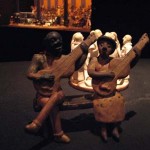 Sunday is market day and Henrique calls and is in town, and he takes me to the Folk Art Museum in Catete – I love this stuff! Then we tour the elegant Catete Palace and then, for a stark contrast, go and walk around Lapa. It’s an even stranger neighborhood by daylight than it was at night. None of the bars open until 8:00 at the earliest, most open at 10:00, so everything is shuttered and the place wears a deserted air with street people sleeping on cardboard and graffiti on every available wall. It reinforces my earlier impression, when I came to see Sueli, that Lapa is a
Sunday is market day and Henrique calls and is in town, and he takes me to the Folk Art Museum in Catete – I love this stuff! Then we tour the elegant Catete Palace and then, for a stark contrast, go and walk around Lapa. It’s an even stranger neighborhood by daylight than it was at night. None of the bars open until 8:00 at the earliest, most open at 10:00, so everything is shuttered and the place wears a deserted air with street people sleeping on cardboard and graffiti on every available wall. It reinforces my earlier impression, when I came to see Sueli, that Lapa is a 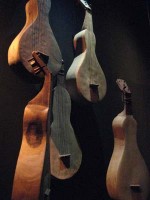 kind of mirage that disappears with the light of day and arises in smoke every evening to weave mysterious strains of music.
kind of mirage that disappears with the light of day and arises in smoke every evening to weave mysterious strains of music.
While we are walking around, Romulo calls and says he and Bonnie are going to a quiosque in Lagoa to hear Daniella Speilman in an hour or so, do I want to go too? Henrique says he can drop me off there so, porque nao? We’re in the Arab quiosque – there are many of these outdoor bars grouped together by the edge of some water. The place has a Key-West feel to it. Daniella is playing soprano sax with a 7-string and “the best drummer in Rio,” according to Romulo. They are great, playing way outside the tunes.
 I don’t have my recorder but take a couple of blurry pics and film (it’s really dark and I don’t ever like to intrude my flash into an event). I go talk to Daniella at break – Romulo says she studied at Berklee, so I speak to her in English. She is very excited about my project here (everyone is, they are so pleased that I’m interested in learning and documenting choro as it is played in Rio today) and says she will tell Ronaldo to call me. Ronaldo do Bandolim is a hugely important choro player who I really want to meet. We stay for another set and Romulo drops me off at home in his car. It’s amazing what a luxury a car seems.
I don’t have my recorder but take a couple of blurry pics and film (it’s really dark and I don’t ever like to intrude my flash into an event). I go talk to Daniella at break – Romulo says she studied at Berklee, so I speak to her in English. She is very excited about my project here (everyone is, they are so pleased that I’m interested in learning and documenting choro as it is played in Rio today) and says she will tell Ronaldo to call me. Ronaldo do Bandolim is a hugely important choro player who I really want to meet. We stay for another set and Romulo drops me off at home in his car. It’s amazing what a luxury a car seems.
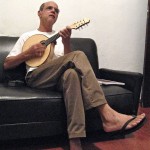 Monday and Tuesday seem to have disappeared from my brain, but Wednesday is Paulo again – see a cavaquinho class he is teaching, and Joel again, where I finally have enough Portuguese to engage in a long conversation about the differences between classical technique and choro technique. He plays classical music with his technique, so can I play choro with mine? The answer is a firm “nao”. Because choro is mainly in first position, and many of the typical ornaments and glisses rely on frequently using a one-finger-per-fret left hand. I can see that, because the melodies definitely seem to come out of chord positions. Today I get my first compliment from Joel, when I play Sonorosa, and he says it’s amazing how much I have improved in 4 weeks. Yippee! I get home precisely at 7:30, because Igor has called Tuesday and said he would come for rehearsal in the evening for our concert Friday, but he doesn’t show. Maybe I misunderstood…
Monday and Tuesday seem to have disappeared from my brain, but Wednesday is Paulo again – see a cavaquinho class he is teaching, and Joel again, where I finally have enough Portuguese to engage in a long conversation about the differences between classical technique and choro technique. He plays classical music with his technique, so can I play choro with mine? The answer is a firm “nao”. Because choro is mainly in first position, and many of the typical ornaments and glisses rely on frequently using a one-finger-per-fret left hand. I can see that, because the melodies definitely seem to come out of chord positions. Today I get my first compliment from Joel, when I play Sonorosa, and he says it’s amazing how much I have improved in 4 weeks. Yippee! I get home precisely at 7:30, because Igor has called Tuesday and said he would come for rehearsal in the evening for our concert Friday, but he doesn’t show. Maybe I misunderstood…
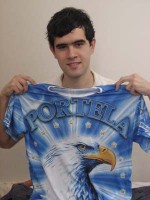 Thursday Nate arrives from Buenos Aires. I clean up, stock up, and go to the airport with TaxiPaulo who offers to wait with me – it’s over an hour while we talk to a retired soccer player who now drives a limo and is waiting for a client on the same flight. Nate appears – it’s great to see him and he is full of Argentinian adventures and ready for more in Brazil. With typical Nate luck he has discovered that he has a friend from Columbia living in Rio, so he’ll have pals to hang with as well as me. We return to Urca and Paulo only charges me for the driving part, not the wait. It occurs to me that I don’t have a picture of his cheerful smiling face so I will have to fix that before the next log. He is really a great help to me, besides driving, and always walks me to the club and makes sure the event is really happening and when I am finished and call he arrives within 15 minutes. He makes me feel very secure.
Thursday Nate arrives from Buenos Aires. I clean up, stock up, and go to the airport with TaxiPaulo who offers to wait with me – it’s over an hour while we talk to a retired soccer player who now drives a limo and is waiting for a client on the same flight. Nate appears – it’s great to see him and he is full of Argentinian adventures and ready for more in Brazil. With typical Nate luck he has discovered that he has a friend from Columbia living in Rio, so he’ll have pals to hang with as well as me. We return to Urca and Paulo only charges me for the driving part, not the wait. It occurs to me that I don’t have a picture of his cheerful smiling face so I will have to fix that before the next log. He is really a great help to me, besides driving, and always walks me to the club and makes sure the event is really happening and when I am finished and call he arrives within 15 minutes. He makes me feel very secure.
Nate calls his friend Lizza and they arrange to meet the next day. We eat a great dinner at Garota da Urca, and walk around my village by night. The next day, Friday, is a holiday (Good Friday) and most businesses are closed. I have the concert with Igor at 12:30 and we’re planning to arrive at 11:00 to practice. As Nate and I are on our way in a cab (just a regular cab from Urca) Marcia calls and says she and Igor are at the museum and it is closed and they will wait for me there. When we arrive Igor is pacing around yelling into the phone. It’s a misunderstanding between the music series – who thought the museum was open – and the museum. So there is no concert, but awhile later I get a call from Paulo who says they will pay us anyway and arrange another concert date and pay for that too. But for now we say good-bye to Igor and Marcia, and Nate and I walk to the metro and go home. I switch music, as there’s a regional rehearsal in Sta Teresa at 5:00, and we take the metro to Copacabana and walk and have lunch. Lizza is going to Sta Teresa too, for some of the holiday festivities, so Nate will meet her there. It’s brilliantly sunny – usual for me, but a treat for Nate who has had a week of rain in Buenos Aires.
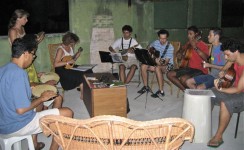 We rendezvous with the band at the appointed corner and go in 3 cars to Sta Teresa, up steep cobblestone streets and drop Nate at a park. We continue on the Carlos’ house, stopped for a few minutes to let a religious parade go past. Drive by some street theater including a guy in a toga and a crown of thorns singing “Got a Whole Lotta Love” in highly-accented English. Our regional is all there, except the flutist, and with the addition of another guitarist. Bonnie has come too, although she leaves in a few days. One of the guitarists has brought his wife who obligingly takes pics and films of the rehearsal.
We rendezvous with the band at the appointed corner and go in 3 cars to Sta Teresa, up steep cobblestone streets and drop Nate at a park. We continue on the Carlos’ house, stopped for a few minutes to let a religious parade go past. Drive by some street theater including a guy in a toga and a crown of thorns singing “Got a Whole Lotta Love” in highly-accented English. Our regional is all there, except the flutist, and with the addition of another guitarist. Bonnie has come too, although she leaves in a few days. One of the guitarists has brought his wife who obligingly takes pics and films of the rehearsal.
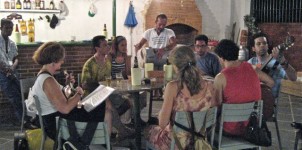 We are playing out on a rooftop terrace overlooking Rio. Most of the songs go well, some have issues, but everyone is really cheerful about it all. Carlos lives in a 3-story 2-rooms-per-floor house that’s really cool. Afterwards some people leave, including Romulo, but most of us stay and go to a bar to drink a beer and talk. We’re about the only ones there, so gradually the instruments come out and we’re playing along with the samba CDs. Then the bar owner stops the CDs and the guys want to play our choro. So we do, and I’m the only melody instrument, but manage to do pretty well. We are a big hit, get free beer, Bonnie and I get praised for being gringos with beautiful souls, I am told that I should record (!!), some big drums come out (from where?) and the owner joins in, some Afro-Brazilian dances are played and Bonnie dances with Carlos’ girlfriend. Big hugs as we part, until the next rehearsal on Wednesday. One of the guys takes Bonnie and me to our homes in a cab and won’t let us pay. Nate arrives home later having had fun too and met some cool people.
We are playing out on a rooftop terrace overlooking Rio. Most of the songs go well, some have issues, but everyone is really cheerful about it all. Carlos lives in a 3-story 2-rooms-per-floor house that’s really cool. Afterwards some people leave, including Romulo, but most of us stay and go to a bar to drink a beer and talk. We’re about the only ones there, so gradually the instruments come out and we’re playing along with the samba CDs. Then the bar owner stops the CDs and the guys want to play our choro. So we do, and I’m the only melody instrument, but manage to do pretty well. We are a big hit, get free beer, Bonnie and I get praised for being gringos with beautiful souls, I am told that I should record (!!), some big drums come out (from where?) and the owner joins in, some Afro-Brazilian dances are played and Bonnie dances with Carlos’ girlfriend. Big hugs as we part, until the next rehearsal on Wednesday. One of the guys takes Bonnie and me to our homes in a cab and won’t let us pay. Nate arrives home later having had fun too and met some cool people.
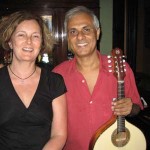 Saturday Nate goes off with Lizza to a music+feijoada event at one of the samba school up north. His pic here is with the samba-school shirt. I have an early show at the Rio Scenarium where Romulo has alerted me that Ronaldo do Bandolim is playing with some musicians. I arrive early without a reservation, but get in, ask a friendly waiter if I can sit at the one unreserved table, he checks and I can. The musicians are sitting on the edge of the stage talking and I ask the waiter if he knows which one is Ronaldo, as the band has been playing there all week. He doesn’t but goes right over and asks, so I introduce myself, and when I say I’m a friend of Paulo Sa, the handshake turns into a kiss on both cheeks and Ronaldo and I sit down and play his bandolim and talk. He’s a cheerful handsome man who loves classical music and tells everyone he talks to afterward what a great tremolo I have. So I’m invited to sit at the band table and talk to the flutist’s g’friend while they play. (Get a couple of thumbs-up from my waiter-friend during this whole process.)
Saturday Nate goes off with Lizza to a music+feijoada event at one of the samba school up north. His pic here is with the samba-school shirt. I have an early show at the Rio Scenarium where Romulo has alerted me that Ronaldo do Bandolim is playing with some musicians. I arrive early without a reservation, but get in, ask a friendly waiter if I can sit at the one unreserved table, he checks and I can. The musicians are sitting on the edge of the stage talking and I ask the waiter if he knows which one is Ronaldo, as the band has been playing there all week. He doesn’t but goes right over and asks, so I introduce myself, and when I say I’m a friend of Paulo Sa, the handshake turns into a kiss on both cheeks and Ronaldo and I sit down and play his bandolim and talk. He’s a cheerful handsome man who loves classical music and tells everyone he talks to afterward what a great tremolo I have. So I’m invited to sit at the band table and talk to the flutist’s g’friend while they play. (Get a couple of thumbs-up from my waiter-friend during this whole process.)
Ronaldo invites me to everything – his next gigs, a roda at his brother’s house in Niteroi on Saturday – and gets my drink card stamped so I don’t have to pay the cover. Big hugs as I leave, and the place is filling up for the next band. It’s a much younger crowd, and the band is flute, lead cavaquinho, bass, drums, and percussion. I’m sorry I didn’t record a bit as it was so odd. But loud, and the club is packed with trendy young Cariocas, and as I exit it’s so loud I can’t even hear Paulo on my cellphone in the street. and there is a line stretching in either direction of hundreds of kids waiting to get in. As I’m waiting for my cab a man comes up to me and mimics mandolin playing – it’s one of the flutists from my repertory class at choro school who is waiting to see if his nephew gets into the club. TaxiPaulo arrives and I’m home by midnight – early for Rio.
 Sunday is Easter and Nate and I go to Maracana – the largest soccer stadium in the world – to see a game. He found a tour online and said the guys seemed cool and they’d pick us up in Urca and it it seemed like a good idea after his experiences navigating Buenas Aires soccer solo. We arrive in a bus of 6 and meet up with about 40 others in other small buses. It’s the international youth brigade. But once inside we find we can sit anywhere in our section, so quickly ditch the gringos and go hang out with Brazilians. An earlier game is just ending, I think it’s a teen-age league.
Sunday is Easter and Nate and I go to Maracana – the largest soccer stadium in the world – to see a game. He found a tour online and said the guys seemed cool and they’d pick us up in Urca and it it seemed like a good idea after his experiences navigating Buenas Aires soccer solo. We arrive in a bus of 6 and meet up with about 40 others in other small buses. It’s the international youth brigade. But once inside we find we can sit anywhere in our section, so quickly ditch the gringos and go hang out with Brazilians. An earlier game is just ending, I think it’s a teen-age league. 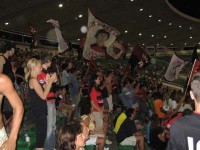 The whole stadium scene is amazing. Nearly everyone in our section is wearing black and red – the Flamengo team colors – and shirts and headbands reading “Mengao”. There’s a drum section and nearly continuous drumming and shouting of rhythmically complicated chants of support for Flamengo, “our team,” who is playing America, from up north (yes, really). Huge flags on long flagpoles are waved and twirled gymnastically in the less crowded sections. Wow – imagine trying to bring anything like that into Fenway! It starts to pour at halftime, so the 2nd half is pretty crazy on the field. Our team wins and will go on to whatever the next stage of the play-offs is. Nate is going back to a game on Wednesday to try to see Romario score “mil,” his 1000 goal. He’s now at 999, and only Pele in the 60’s has ever scored 1000, so it’s a big event here and there’s a lot of anticipation.
The whole stadium scene is amazing. Nearly everyone in our section is wearing black and red – the Flamengo team colors – and shirts and headbands reading “Mengao”. There’s a drum section and nearly continuous drumming and shouting of rhythmically complicated chants of support for Flamengo, “our team,” who is playing America, from up north (yes, really). Huge flags on long flagpoles are waved and twirled gymnastically in the less crowded sections. Wow – imagine trying to bring anything like that into Fenway! It starts to pour at halftime, so the 2nd half is pretty crazy on the field. Our team wins and will go on to whatever the next stage of the play-offs is. Nate is going back to a game on Wednesday to try to see Romario score “mil,” his 1000 goal. He’s now at 999, and only Pele in the 60’s has ever scored 1000, so it’s a big event here and there’s a lot of anticipation.
Today was a lazy beach day at Apoador. Nate has got me drinking Acai – a berry that makes a tasty health drink, and arrives as a dark brown icy slush – and so we are frequenting the many juice bars in Rio. He’s off with Lizza now and I’m finishing up this log and hoping to get a couple of hours of practice in tonight.
This log’s sonnet was written after the Guinga concert. I was really knocked out by his songs, and by his intense focus on the music as he was performing. The last piece he played was titled “Comendador Albuquerque,” and he exited the stage afterwards without fanfare, leaving us with just his music.
Comendador he leaves the room full of
the passion of his words his sounds stab through
the air not pausing nothing more to do
he decimates the bright facade of love
fall into his songs if you dare but this
is not a man who comes to entertain
with superficial beauty for his pain
as hope can purify as fire his
notes offer up redemption for the soul
nothing less if you’re not willing clap end
the radiance in this moment pretend
it’s just a song shut the door to the whole
universe placed carefully in your hand
a gift you still may come to understand
I hope the spring snowstorms in New England are finally through, and you are now enjoying warmer days. I’ll be back with more music and adventures to recount in a couple of weeks. My friend Betty arrives this weekend, so with 2 houseguests I may even venture out of town, although right now I feel like I never want to leave Rio ever.
